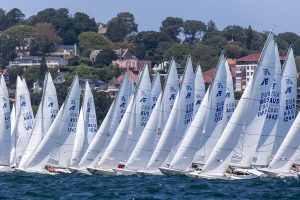

Photo – Andrea Francolini
The Importance Of The Start – It’s no secret that the importance of the start is the key to a successful regatta.
Good starts give you the best chance of sailing your own race and being able to implement your pre-determined strategy.
When you start poorly, you are dictated to by the fleet and are constantly searching for a clear lane. In most cases, you are sent where you don’t want to go and more often than not, end up on the wrong side of the course.
SAILING TO WIN BOOK AND BONUSES
Goals for a Good Start – The Importance Of The Start
- Be moving at full speed on the gun, be on the line and have clear air.
- Sailing toward the favoured side of the course with a wide lane of clear air.
- Start as close to the favoured end of the line without massive traffic and have space below to enable you to put the bow down.
Determine the Favoured End
- Do a head-to-wind in the centre of the line to work out which end of the line your bow points more closely to. That is the end that is favoured.
- With a compass, sail along the starting line on starboard tack. Note the compass reading, then turn the boat head-to-wind and note the compass reading. If the heading is less than 90 degrees greater than the compass course down the line, the pin is favoured. If the number is more than 90 degrees, the boat end is favoured.
Deciding Where To Start
The favoured end may not always be the best place to start. You must weigh up whether there are large clumps of boats slowing each other down and creating a potential wind shadow.
Only a small number of boats can emerge sailing at full speed from a large group. The bigger the pack, the worse your odds of escaping with a good start.
If the racecourse is biased to one side due to current or geographic wind effects, the favoured side of the course may be closer to the unfavored end of the starting line.
When the pin is favoured, but the wind is oscillating, starting at the favoured end can make it difficult to get onto port tack. If this happens, you end up headed on starboard and eventually out of phase.
Be Prepared to Change Your Strategy
Smart sailors know how and when to reorder their priority list because every race presents a different set of conditions.
There are times when the favoured end is closest to the favoured side of the course and it is better to just bite the bullet, start in the pack, and take your chances.
Even the fastest boats go slow when they are stuck in packs of boats. Regatta winners often gain their advantage early in each race. They avoid problems at the start that can keep them from sailing at full speed.
Do Your Own Thing
A good start only works when it’s done in conjunction with your upwind strategy.
Before the start, think about which side of the racecourse is favoured, where you want to go, and why.
If you want to go left, continue on starboard tack after you start. If you like the right side, look for opportunities to tack to port and get out to the right.
The advantage of finding a less crowded spot on the line is the freedom you get to follow your game plan.
Simple Rules – The Importance Of The Start
- Find a clear comfortable spot on the starting line and be prepared to tack or gybe away to get a spot with clear air.
- Have enough space to allow you to accelerate to full speed by the time you hit the line.
- With 30 seconds to go create as much space to leeward as possible.

